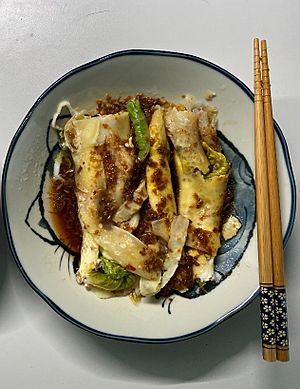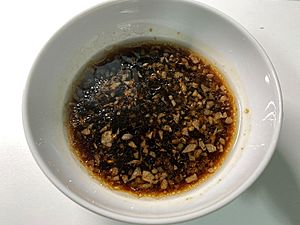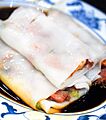Rice noodle roll facts for kids

Stone rice noodle rolls
|
|
| Alternative names | jyu cheung fan, chee cheong fun |
|---|---|
| Course | Dim sum |
| Place of origin | Guangdong |
| Main ingredients | rice noodles |
| Variations | shrimp, pork, beef, or vegetable filling, youtiao |
| Rice noodle roll | |||||||||||||
|---|---|---|---|---|---|---|---|---|---|---|---|---|---|
| Chinese name | |||||||||||||
| Traditional Chinese | 腸粉 | ||||||||||||
| Simplified Chinese | 肠粉 | ||||||||||||
| Hanyu Pinyin | chángfěn | ||||||||||||
| Cantonese Yale | chéungfán | ||||||||||||
| Literal meaning | Intestine noodle | ||||||||||||
|
|||||||||||||
| Alternative Chinese name | |||||||||||||
| Traditional Chinese | 豬腸粉 | ||||||||||||
| Simplified Chinese | 猪肠粉 | ||||||||||||
| Hanyu Pinyin | zhūchángfěn | ||||||||||||
| Cantonese Yale | jyūchèungfán | ||||||||||||
| Literal meaning | Pig intestine noodle | ||||||||||||
|
|||||||||||||
| Thai name | |||||||||||||
| Thai | ก๋วยเตี๋ยวหลอด [kǔa̯j.tǐa̯w lɔ̀ːt] | ||||||||||||
| RTGS | kuaitiao lot | ||||||||||||
A rice noodle roll is a yummy dish from Guangdong Province in southern China. People often eat it as a snack, a small meal, or as part of a bigger meal called dim sum. Dim sum is a style of Chinese cuisine where small portions of food are served.
This dish is made from a thin roll of rice noodles. It can be filled with tasty things like shrimp, beef, or vegetables. After it's cooked, a special soy sauce is poured over it. Sometimes, this sauce even has drippings from roasted meats!
When the rice noodle roll has no filling, it's called jyu cheung fan. In Cantonese, "jyu" means "pig," "cheung" means "intestine," and "fan" means "noodles." It got this name because the plain noodle roll looks a bit like a pig's intestine.
No one knows exactly when rice noodle rolls were first made. Most old cooking books say that jyu cheung fan started around the 1930s. It became a popular breakfast or snack sold in many street restaurants. In Guangzhou, people called it laai cheung because the noodles are "pulled" or "pushed" by hand when they are made.
Contents
How Are Rice Noodle Rolls Made?
The noodle sheets are made from a mix of rice flour and other flours like tapioca or glutinous rice flour, plus water. This mix is like thick cream. The rice flour gives the noodles their main texture and taste. The tapioca flour makes them stretchy and bouncy.
This liquid mix is poured onto a special flat pan with holes. Restaurants often use big steamers with a cloth lining. The noodle mix is steamed from the bottom up. This creates thin, square rice noodle sheets, usually about 1/8 of an inch thick.
Adding Fillings and Serving
While the noodle is cooking, fillings like shrimp or beef can be added. As the noodle steams, it wraps around the filling. This keeps the filling inside when the noodle is moved. After a few minutes of steaming, the fresh noodle is carefully scraped off the cloth. It's then placed on a lightly oiled metal surface to stop it from sticking.
The noodle is usually folded about three times. Before serving, a warm, slightly sweet soy sauce is added. Cantonese and Hong Kong style Cheungfan are usually folded gently when they have fillings inside.
The noodle itself doesn't have much flavor. The yummy taste comes from the fillings and the soy sauce. Common fillings include fresh or dried shrimp, beef (mixed with rice flour), or pork with chopped green onions.
Rice noodle rolls are usually served in groups of three. They are often cut to show the filling inside. In some places, they are served plain with no filling. Instead, they have toppings and a thick sauce on top. Rice noodle rolls are always served hot and fresh. They come with a splash of plain or flavored oil and lots of warm sweet soy sauce. Many places have their own special sweet soy sauce, sometimes with hoisin sauce added.
Different Kinds of Rice Noodle Rolls
Cantonese Style Rice Noodle Rolls
In Cantonese cooking, rice noodle rolls are a popular part of dim sum. Here are some common types you might find:
- Beef rice noodle roll
- Shrimp rice noodle roll
- Dried shrimp rice noodle roll
- Char siu (barbecued pork) rice noodle roll
- Zhaliang (rice noodle roll wrapped around a fried dough stick)
Some newer kinds you might see include:
- Rice noodle roll with chicken and bitter melon
- Rice noodle roll with conpoy (dried scallop) and pea shoots
- Rice noodle roll with fish
- Stir-fried rice noodle roll with XO sauce
In Guangzhou, you can find a special kind with sliced meat. These are often sold at street restaurants as a meal. They use whole pieces of meat, like beef or pork, instead of ground meat. Before rolling, fresh lettuce is added inside. This makes the cheungfan crunchy and bigger.
Southeast Asian Style Rice Noodle Rolls
In Penang, Malaysia, chee cheong fun is served with a shrimp paste called hae ko. In Ipoh, Malaysia, chee cheong fun comes in two main ways: dry or wet.
- The dry version has a bright red sweet sauce, often with chili sauce and pickled green chili.
- The wet version has curry with pork rind and long beans, or gravy with minced meat and shiitake mushrooms.
Both dry and wet versions are topped with sesame seeds and fried shallots.
Teluk Intan, another town in Malaysia, has its own unique chee cheong fun. It includes turnips, shallots, and deep-fried shrimp.
Chee cheong fun is a popular breakfast food in Singapore and Malaysia. You can find it in kopitiams (coffee shops) and Chinese restaurants. It's also found in Bagansiapiapi, Indonesia. There, it's called tee long pan or tee cheong pan. This version is served with red chili sauce, crushed roasted peanuts, fried shallots, and dried shrimp.
Vietnamese Style Rice Noodle Rolls
In Vietnamese cuisine, there's a similar dish called bánh cuốn. People mostly eat it for breakfast. It's like a thin crêpe made from rice noodles. It can be filled with ground pork and other ingredients.
Side dishes often include chả lụa (Vietnamese pork sausage) and bean sprouts. The dipping sauce is called nước chấm. Sometimes, a tiny drop of a special essence from a giant water bug is added to the nước chấm for extra flavor. This ingredient is rare and quite expensive.
Images for kids
See also
 In Spanish: Rollo de fideo de arroz para niños
In Spanish: Rollo de fideo de arroz para niños










